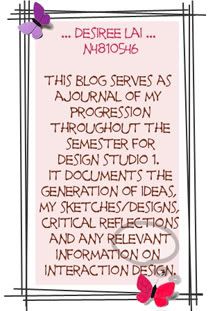

Monday, May 01, 2006
- Design research VS Market research
Design research has often been mistaken as market research. The main goal of market research is to find out what potential customers need and to assist in figuring out ways to persuade the target audience to purchase the product. But that is not the case for this project.
Unlike market research, “design research can enable the product to speak for itself, freeing branding and marketing to move toward honest communication and away from persuasion and the creation of desire” (Laurel, 2003). It is aimed at gaining insight into what would serve or delight people in regards to the product; investigating clues that can inform design (Laurel, 2003). It is important to know when to integrate research into the design process as “new and unexpected questions emerge directly from the act of design” (Zimmerman, 2003).
- Methodology for overall project
The development of this project has to follow an iterative process where the product is developmented incrementally and user testing is conducted on the prototype, allowing the developer to take advantage of what what is being learned to tackle problems highlighted and improve the prototype even further (Usabilis, 2006; Wikipedia, 2006). With every successive iterations, it brings the developer closer to achieving the finished product. The iterative process for this project involves the analysis of the underlying structure of game, usability, efficiency and achievement of goals set by the team managing the project.
 Here is a diagram showing how the iterative design process works. After developing the first prototype, it would have to be tested and the findings will then have to be analyzed. Refinements are made to the design and the cycle repeats itself. Using this model, the requirements and design are continuously refined. The project develops through an ongoing dialogue between the designers, the design, and the testing audience and an iterative design process will not only streamline development resources, but will also result in a more robust and successful final product (Zimmerman, 2003).
Here is a diagram showing how the iterative design process works. After developing the first prototype, it would have to be tested and the findings will then have to be analyzed. Refinements are made to the design and the cycle repeats itself. Using this model, the requirements and design are continuously refined. The project develops through an ongoing dialogue between the designers, the design, and the testing audience and an iterative design process will not only streamline development resources, but will also result in a more robust and successful final product (Zimmerman, 2003).- Vertical prototyping
Based on the level of interaction with the prototype, Nielsen (1993) suggests that prototyping can be divided into 2 levels; vertical and horizontal prototyping. For this project, the low-fidelity prototype (Labyrinth) is considered a vertical prototype as it “implements a consistent set of simulated functionalities in order to allow the user to achieve a typical scenario of use” (Nielsen, 1993). It is in this prototyping phase that series of user tests have to be conducted.
- Research methodology
The three bases of ethnographic methodology are Naturalism, Understanding and Discovery and have to be taken into consideration because it has a great influence on the data collection process.
unit links
- KIB210 OLT
- Jane Turner - Interaction
- Jane Turner - Lecture 8
- Jane Turner - Lecture 9
- Jane Turner - Class notes
useful transits
- Jens Jensen - Interactivity
- Fundamentals of Interactivity
- Writing a critique
- Jonas Lowgren - Sketching Interaction Design
- How to create a clear project plan
- Prototyping
- Usability methods
- A Theory of Fun for Game Design" - What Games Aren't
- Flash kit
- Ljudo.com - Sound effects database
- Sounddogs - Sound effects database
- Critical Incident Technique Analysis
- Gamasutra